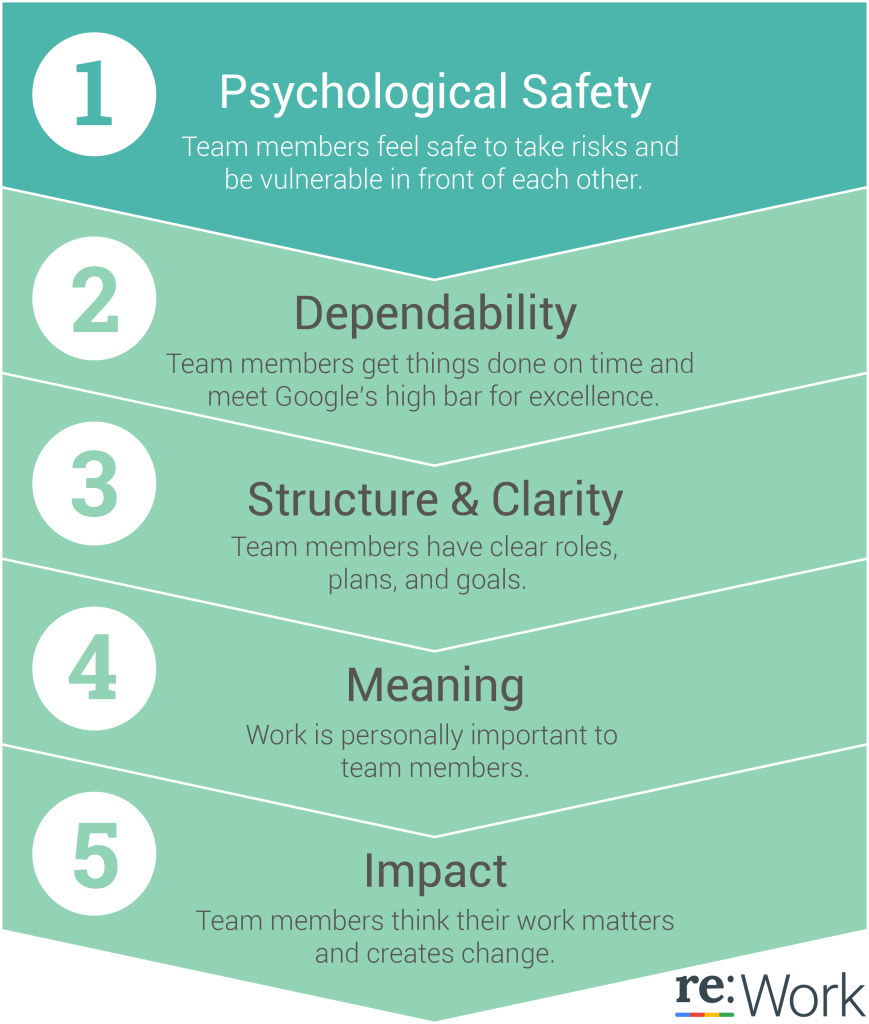Meetings where people don’t speak out what they think. Business conversations that are dominated by one person with no room for others to contribute knowledge or ask questions. Brainstormings where ideas are criticised even before the sentence is finished. These examples unfortunately still are common in a lot of businesses, even in times of flat hierarchies, teamwork and start up culture. And they clearly lack the key characteristics of high performance teams.
A group of great professional individuals is not a team.Shine
Lack of trust and fear to take interpersonal risks within a team are at the roots of these symptoms. The consequences: people suffer, teams underperform. At the very heart of these malfunctioning teams, we find a lack of psychological safety – the single most important key condition for high performance teams. According to a two years research by Google, a psychologically safe climate is by far the most important characteristic of successful teams, which is what we at Shine also see again and again in our executive team coaching engagements.
Psychological safety, Dependability, Structure & Clarity, Meaning, Impact are key to high performance teams
What does psychological safety mean? It describes a teamwork environment where team members feel safe to take risks without feeling insecure or embarrassed. They can be vulnerable in front of each other without fear to suffer harmful consequences. If teams work in a psychologically safe climate, team members can ask apparently dumb questions, articulate opinions that are contrary to the majority, and ask for clarification even if it could “negatively influence how others perceive our competence, awareness, and positivity”.
Though psychological safety is a the core of high performance teams, Google’s teamwork definition identified four additional team characteristics as key to good team work:
- Dependability: Team members get things done on time and meet the shared quality standards of work
- Structure & clarity: Team members have clear roles, goals, and plans
- Meaning: Work is personally important to each of the team members
- Impact: Team members think their work matters and creates change
Google’s data-driven insights tie perfectly into Patrick Lencioni’s model of The Five Dysfunctions of a team. Google’s psychological safety is the solution to the two fundamental dysfunctions of teams Lencioni identified: lack of trust and fear of conflict.
Psychological safety affects pretty much every important dimension we look at for employees. Individuals on teams with higher psychological safety are less likely to leave Google, they’re more likely to harness the power of diverse ideas from their teammates, they bring in more revenue, and they’re rated as effective twice as often by executives.Google re:Work
Tips to create a safe space for high performance teams
In my own experience – both leading and coaching teams -, developing these safe high performance team dynamics takes time and a clear intention from the leader. Like with trust, people tend to need some proof and explicit allowance before they are willing to put themselves at risk and be vulnerable.
Be the role model
You must be the example of the things you expect from your team members. In order to create a safe space and benefit from the advantages of teamwork, you must expose yourself. You must admit own errors openly. Keep in mind that your own behaviour is a master key to creating or impeding the safe teamwork environment.
Demonstrate engagement and show understanding
If you want others to engage, show engagement first. You can explicitly ask for questions, doubts or feedback. This gives the team allowance to actually express their thoughts. Be focused on the conversation and listen. Don’t pretend, do it really. Pay attention to your body language and facial expressions, they speak without words. And make sure not to use nor to allow the use of toxins, plus keep focussing on solutions rather than looking at the problems.
Be inclusive in decision-making and interpersonal settings
On top, make sure to respond respectfully and express gratitude to challenging questions and contrary opinions. Make sure not to interrupt your colleagues or allow interruptions, and show confidence and conviction without appearing inflexible.
It only works if you really believe in what you are doing
All these techn¡ques will help you to build a safe environment for a successful high performance team. But only if you fulfill the following condition: in your guts, you must believe in this way of leadership. You must believe that it matters more how the team members interact than who is on the team.
We human beings have a sixth sense to identify authenticity. If you don’t believe in this way of leading, people will notice the fake – and lose trust, the basis teams and relationship rely on.
More in-depths readings on high performance teams
If you want to read more about Google’s insights on team effectiveness, check these links:
New York Times long piece on Google’s Aristotle project: What Google learned from its Quest to Build the perfect Team
Practical Google Guide on Teams: Understanding Team Effectiveness




2 Responses
Great article Rabieh.
In so many companies team members do not speak in team meeting for different reasons. One prominent reason is that team members, from my experience seem to feel they are not psychologically safe because a manager or managers seem to think what they say is the rule to follow alone. If you suggest a small issue or idea on their statement, you could be considered not a real team player or resisting the managers suggestion. Typically when this happens everyone in the meeting lock up and free and open communication flow halts.
The suggestions above are wonderful and would be effective within an organization that is open with employees. Do you have any suggestions for team members who have a manager or environment like this to create more authenticity among the team, and less paranoia and critical reaction from a manager? Is there a way to possibly, as a team to bring a manager around to listen to real team issues such as trust, especially with management?
Thank you.
Thanks a lot for your great question, Theresa. You are right, it’s easier to implement psychologically safe spaces in environments with the type of manager who is aware of him/herself. Unfortunately a lot of company cultures do not support self-awareness, but force people to put on a mask – with any level of responsibility and on all levels of hierarchy. Still behind these masks, there is always a person. With thoughts, and especially with emotions.
It might seem slightly contradictory and even challenging, still the first thing that comes to my mind is asking you if you understand or can imagine why the manager behaves the way he/she behaves? Try to put yourself in the shoes of the person and honestly – pay attention not to drop back into your own perspective – sense (1) how he/she feels about the team, and (2) what he/she needs from the team. A lot of different things might pop up.
Once you feel you have a reasonably good sense of his/her feelings and needs, imagine you being the relationship between the manager and yourself (or the manager and the team). As the relationship (which means as the connection between the manager and you/the team), (a) how do you feel? (b) What do you need? (c) what do you know that neither the manager nor you/the team know?
With this exercise you probably will find some valuable insight to decide the appropriate step to proceed. To nurture your thoughts, here go two possible ways to go forward:
Sometimes it’s as simple as talking openly to the person. I like a quote by Google’s Executive Chairman Eric Schmidt who said that “the one thing people are never good at is seeing themselves as others see them”. It can be challenging to find the courage to share the observations openly. You can talk on an individual level, as a team or even engage a person the manager trusts. Take into account the COIN way of communicating and the antidotes in the referred 4 toxins post.
One other way is to nurture the person with material he/she might find appealing. E.g. how-to guides, articles about persons/companies the manager appreciates, business cases or posts like this one.
I hope this is helpful. Feel free to follow up in case of doubts/questions.